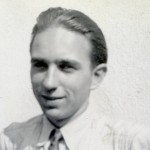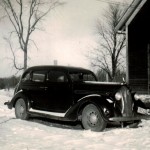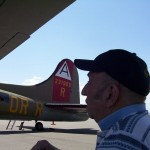 In 1938 to 1939, my dad moved from the family farm, into town so he could attend vocational school. He studied sheet metal fabrication. After he graduated, he moved to Santa Monica, California, at the very young age of just 17 years, and went to work for Douglas Aircraft. Uncle Bill, dad’s brother, let him take his 1934 Plymouth, which broke down on the way there, and Dad had to wire his dad for the money to fix it. It’s pretty had to fix a broken down car, when you are on the way to a new job. Most of us don’t have a lot of money at that point, and after the Great Depression, the country was just starting to come back. This job would begin to move my dad into a position for some of his future jobs, later in life, beginning with his military placement as a Flight Engineer. The Flight Engineer had to know everything about the plane, because it was his job to try to get them back to the base safely…even if something went wrong with the plane. There was no place to pull over when you are flying at 25,000 to 30,000 feet. There was at least one time I know of that Dad was the only reason they came back safely, because the landing gear would not go down. He had to hang upside down in the open bomb bay and crank it down by hand.
In 1938 to 1939, my dad moved from the family farm, into town so he could attend vocational school. He studied sheet metal fabrication. After he graduated, he moved to Santa Monica, California, at the very young age of just 17 years, and went to work for Douglas Aircraft. Uncle Bill, dad’s brother, let him take his 1934 Plymouth, which broke down on the way there, and Dad had to wire his dad for the money to fix it. It’s pretty had to fix a broken down car, when you are on the way to a new job. Most of us don’t have a lot of money at that point, and after the Great Depression, the country was just starting to come back. This job would begin to move my dad into a position for some of his future jobs, later in life, beginning with his military placement as a Flight Engineer. The Flight Engineer had to know everything about the plane, because it was his job to try to get them back to the base safely…even if something went wrong with the plane. There was no place to pull over when you are flying at 25,000 to 30,000 feet. There was at least one time I know of that Dad was the only reason they came back safely, because the landing gear would not go down. He had to hang upside down in the open bomb bay and crank it down by hand.

My dad was very good at the work he did for Douglas Aircraft, but on December 7, 1941, everything changed. Dad left California, in the 1936 Plymouth he had bought, and came home just as the United States was entering World War II. His plan, of course, was to join the Army Air Forces. He was a perfect match for the Army Air Forces, because of his knowledge of air craft, and they saw that right away. He was put into training, and placed on a B-17G crew, as the Flight Engineer, and stationed at Great Ashfield, Suffolk, England. His crew left Texas, and flew to New York City, on April 1, 1944, where they refueled and went on to England.
Most crews on B-17G planes had to fly 35 missions before they could come home, but at Great Ashfield, because of how dangerous that area was, they only had to fly 25. My dad ended up flying 26 before he came home. I don’t think his family knew how dangerous that base was, because my dad would not have told them. “The average life of a B-17 bomber at Great Ashfield was just over 4 months. Very few B-17 bombers that were transferred to the base lasted a complete tour of duty. The average Airman lasted 15 combat missions and few completed an entire tour of 25 missions. Much less 35 !!!! The average LIFE of a Ball Turret Gunner in combat was 12 MINUTES.” Knowing that my dad somehow beat those odds, reminds me of  the many miracles in his life. His crew did lose at least one Ball Turret Gunner, and my dad tried everything he could to save his life, but it was no use…he was gone.
the many miracles in his life. His crew did lose at least one Ball Turret Gunner, and my dad tried everything he could to save his life, but it was no use…he was gone.
In later years, Dad would work for Fred Dewell, as a welder and sheet metal fabricator. His training at vocational school and Douglas Aircraft made him an asset to that company. Then Dad went to work for WATCO, building the boxes for Caterpillar trucks. He was one of their best welders, and was remembered by the people who worked there for many years after his retirement. His training as a young man of only 16 years, served him well all of his life, and I have always been very proud of the things he did in his lifetime.


Leave a Reply